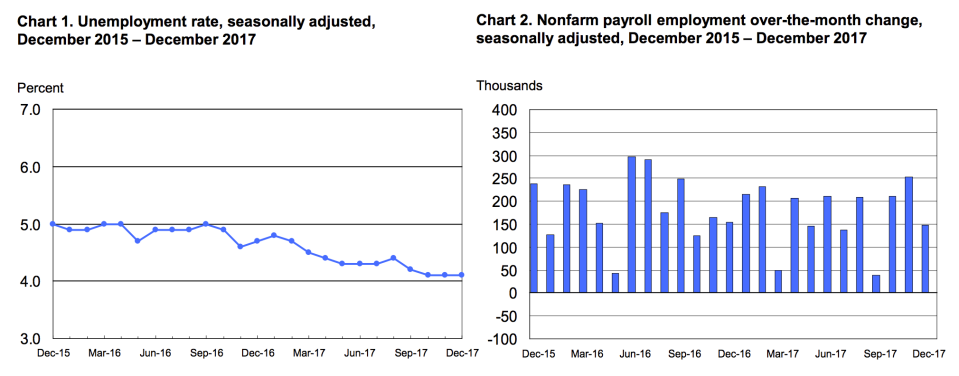Job gains disappointment, unemployment holds at 17-year low
The labor market ended 2017 with a slight disappointment.
The December jobs report from the Bureau of Labor Statistics showed nonfarm payrolls grew by 148,000 while the unemployment rate stayed steady at 4.1%, slightly missing expectations.
Economists expected nonfarm payrolls grew by 190,000 in December while the unemployment rate was expected to remain at 4.1%. The unemployment rate is currently at the lowest level since December 2000. November’s jobs increase was also revised higher to 252,000 from an initial print of 228,000.

Wages were another major focus of this report, which showed average hourly earnings rising 0.3% over last month and 2.5% over the prior year. Expectations were for increases of 0.3% and 2.5%, respectively.
The relative lack of wage growth in the economy has been a surprise to many economists given the low level of unemployment. Friday’s report continues this trend of wage growth that is decent, but not accelerating as some have expected. And without an acceleration in wage growth, it is unlikely that the Federal Reserve will need to alter its plan to raise interest rates three times in 2018, as tempered wage gains won’t be expected to provide unexpected upward pressure on inflation.
Following this report, U.S. stock futures were higher with Dow futures up almost 100 points, S&P 500 futures up 10 points, and Nasdaq futures up 34 points. On Thursday, each of the major equity indexes hit new records as the Dow topped 25,000 for the first time.

Other figures that economists were keeping an eye on Friday include the labor force participation rate, which stayed put at 62.7%, as well as the underemployment rate.
The underemployment rate, which captures not only those out of work but workers who are working part-time but want full-time employment, hit 8.1% in December.
In November, the underemployment rate was 8%, just off its post-crisis low of 7.9% hit in October; President Donald Trump’s chief economic advisor Gary Cohn has said this is a number the administration is focused on lowering.
With Friday’s report, job gains have now averaged 204,000 over the last three months and 2017 officially becomes the sixth-straight year more than 2 million jobs have been added to the economy.
By industry, the retail sector saw the largest decline in employment with this space losing 21,000 jobs against November, when over 26,000 jobs were created.
Construction was a standout with 30,000 jobs created in the sector while manufacturing employment also increased by 25,000 in December. Overall, 55,000 jobs were created in the goods-producing sector with 91,000 jobs being created in services. Education and health services, as well as leisure and hospitality, added nearly 30,000 jobs to pace the services sector.
—
Myles Udland is a writer at Yahoo Finance. Follow him on Twitter @MylesUdland
Read more from Myles here:


